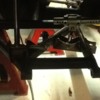I made a new rear swaybar on my car, and while working on the lower rear A arm, it started to make some ratteling noises. They look real good at the outside. No damage at all. But it must be rusted at the inside. If I shake them you can feel stuff moving around at the inside.
So will this be a problem ? I have never seen an A arm fail, but one must be the first. Rather not mine


